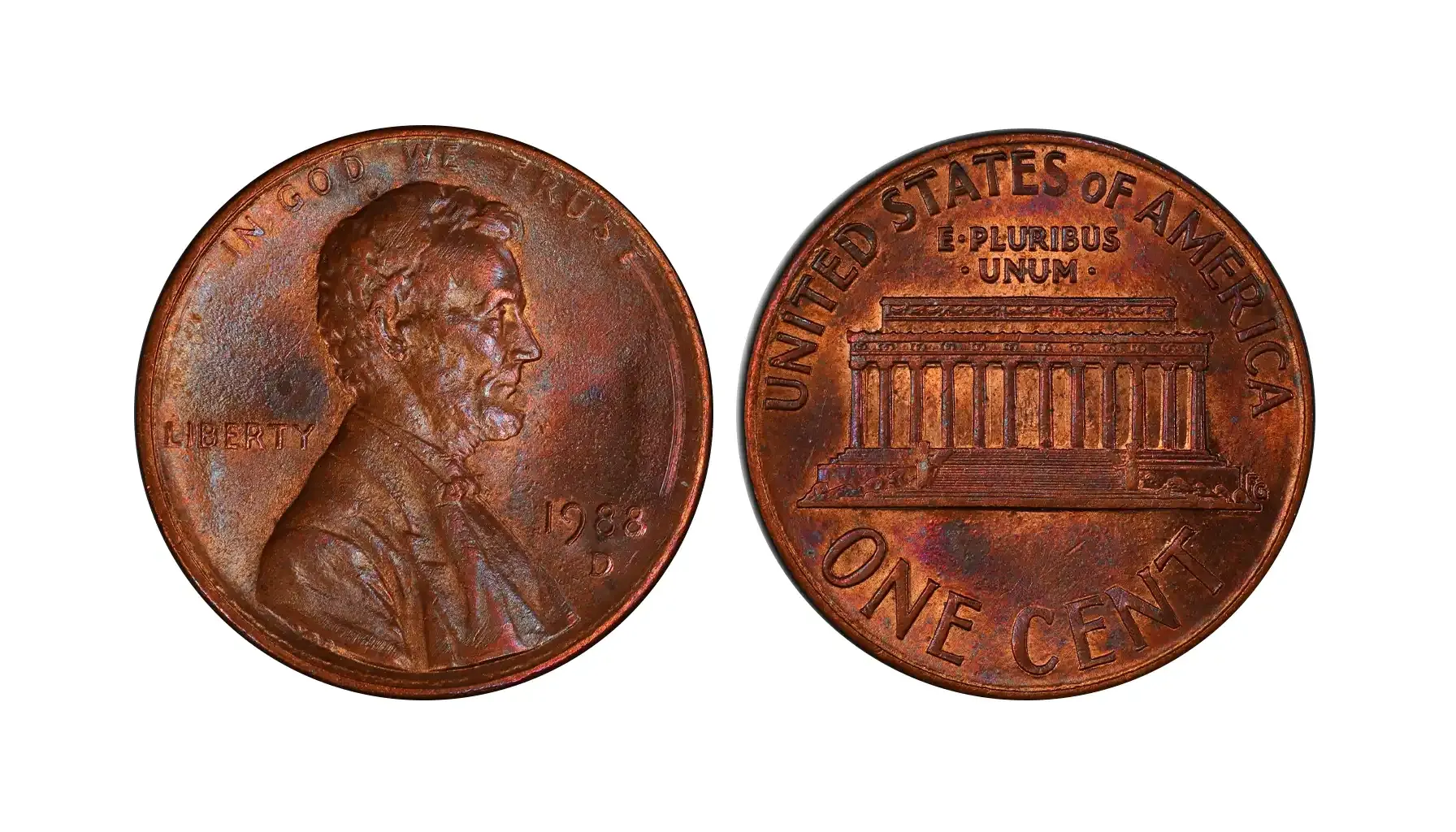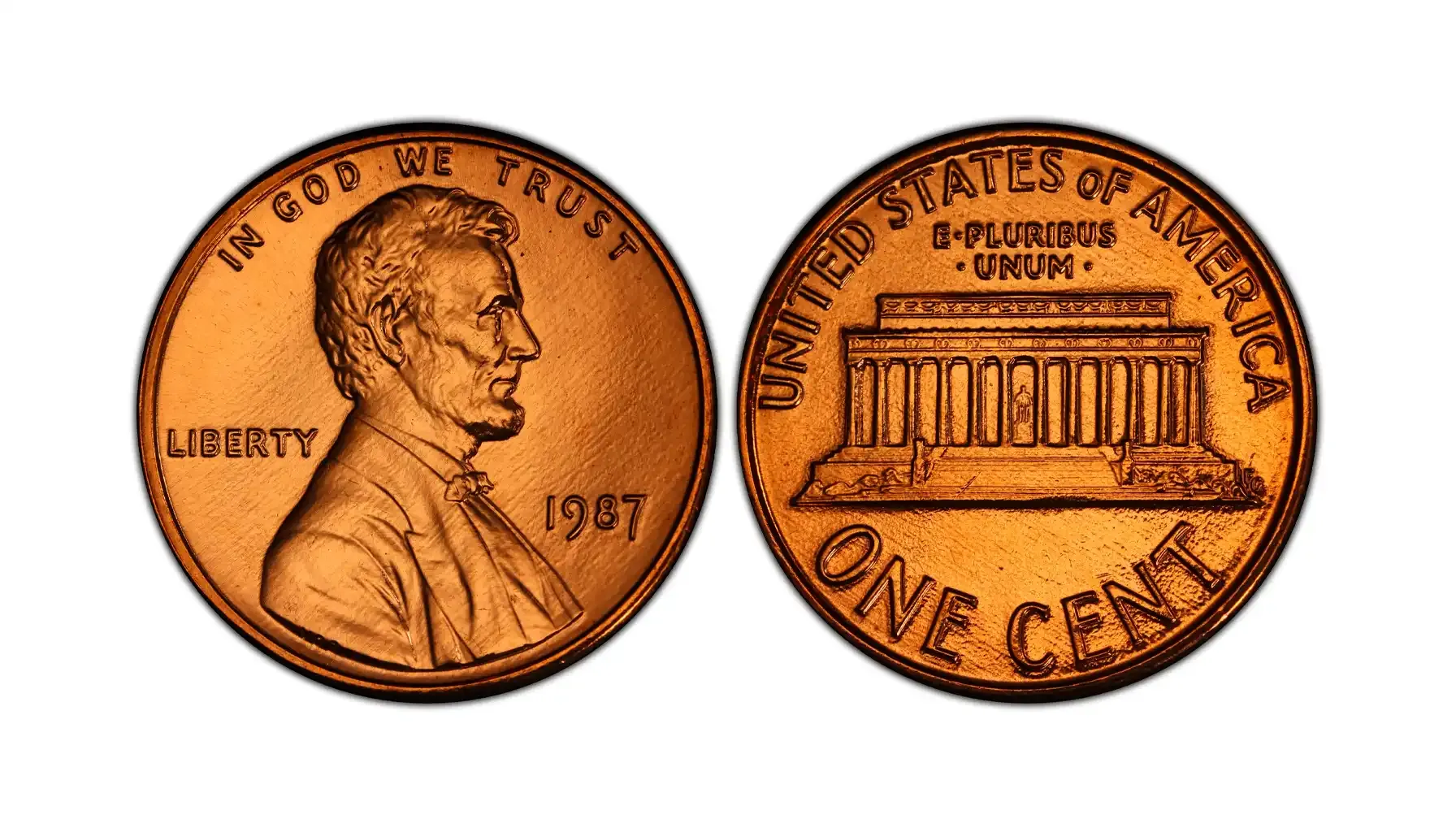Contents:
- Overview of the 1914 Barber Dime and Its Legacy
- How Much Is a 1914 Dime Worth Today?
- Mint Marks Explained: P, D & S Barber Dimes
- 1914 D Barber Dime: Scarcity and Value
- 1914 S Barber Dime: Why This Mint Mark Stands Out
- 1914 Dime Errors and Varieties: What to Watch For
- Composition and Silver Content of the 1914 Dime
- Other 1914 Dime Types: Mercury and Mini Varieties
- Is a 1914 Liberty Dime Worth Collecting?
The 1914 Barber dime stands out as a semi-key date in the Barber series. The United States Philadelphia Mint produced fewer of these coins than most other years. The Barber design replaced the seated liberty on dimes quarters and half dollars. Collectors prize the 1914 issue for its scarcity and historical significance. Each surviving example carries both age and charm that appeal to numismatists.
This guide helps you spot high-grade 1914 Barber dimes and rare mint marks. You will learn how to examine wear, check for Full Liberty stamps, and identify subtle die variations. Explain grading standards and market trends for these collectible coins. Use these tips to learn how to check old coin value.
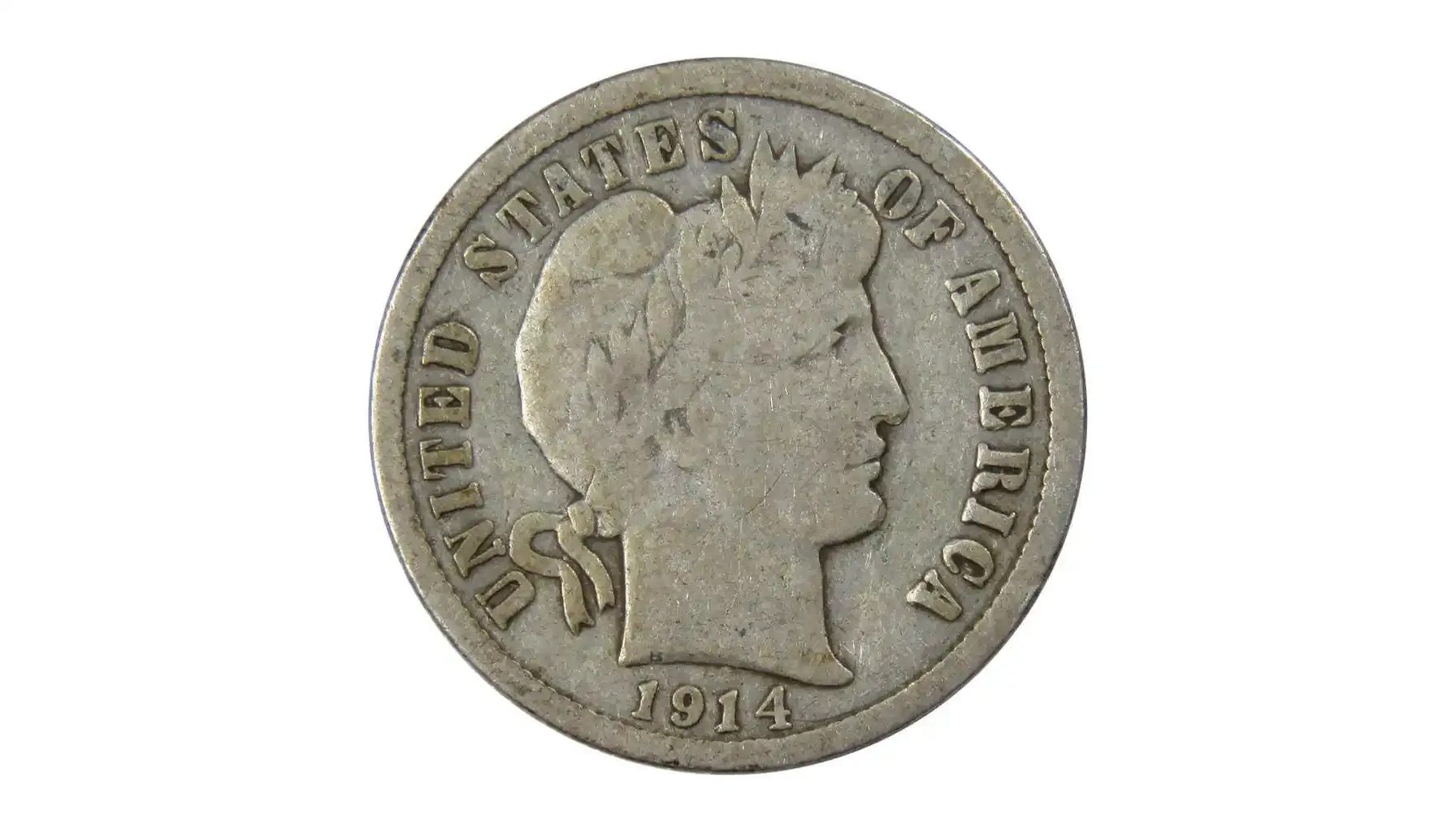
Overview of the 1914 Barber Dime and Its Legacy
The 1914 Barber dime marks a low-mintage year in the Barber series. The Philadelphia Mint struck only 292,000 of these dimes, making surviving pieces scarce. Its smaller production run gives it appeal among date collectors.
Collectors often refer to the 1914 Liberty dime when discussing design details. They study the Liberty head’s engraving and check for full band detail across her headband. That level of detail affects grading and eye appeal.
The 1914 US dime value today reflects both condition and rarity. Circulated examples trade for several dollars, while high-grade specimens can fetch hundreds or more. Understanding market trends helps you gauge current prices.
Reasons the 1914 dime is considered a semi-key date
Low mintage of only 292,000 coins from Philadelphia
High demand among Barber series completists
Enhanced collector interest when well-preserved full band details appear
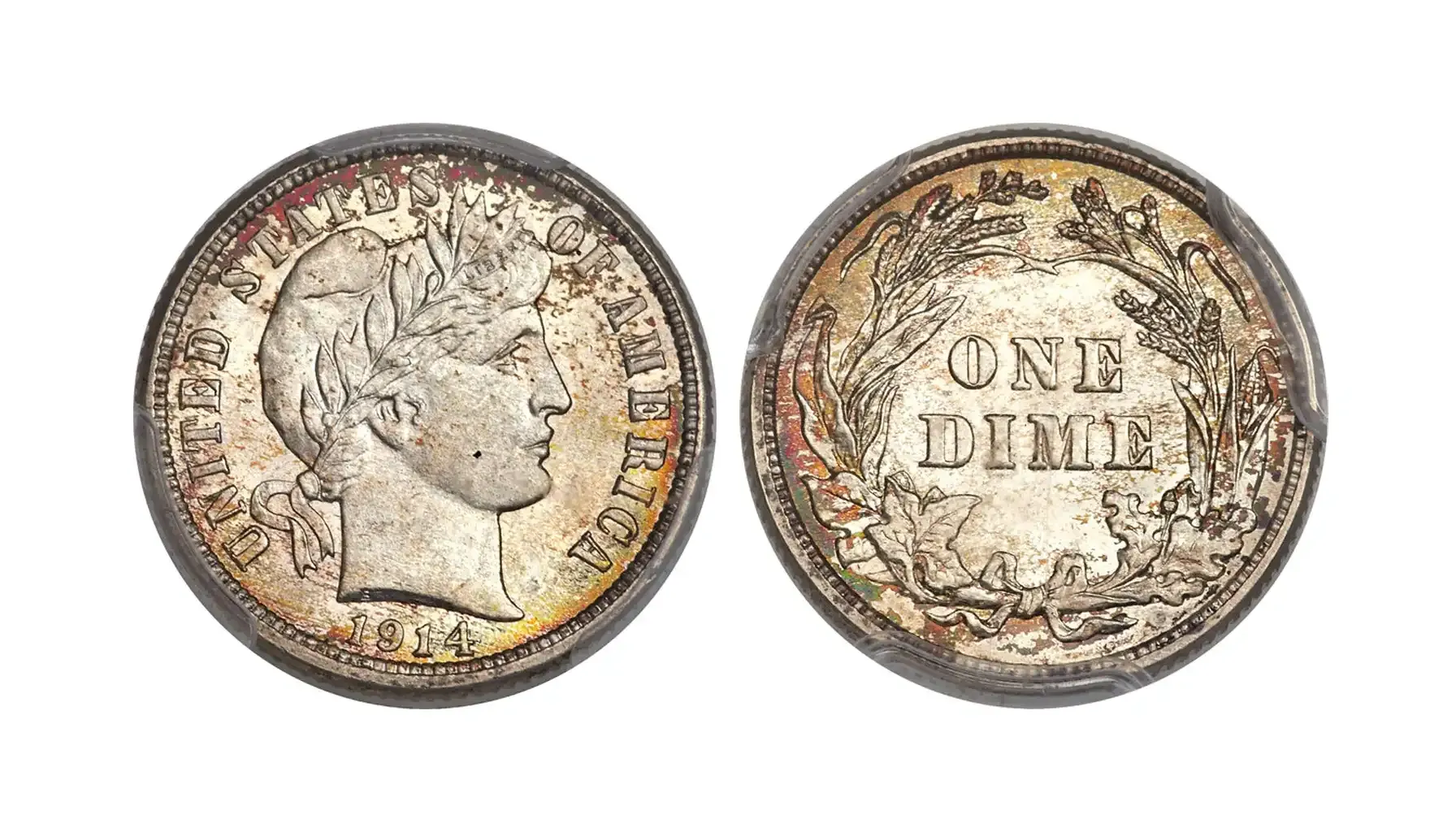
How Much Is a 1914 Dime Worth Today?
Collectors often ask how much is a 1914 dime worth when they spot one at a show or in an old folder. In average circulated grades, such as Good (G) or Very Good (VG), these coins trade for modest amounts. Low-grade pieces start around $5 and slowly increase as the wear decreases.
Many dealers list what is a 1914 dime worth by distinguishing between Philadelphia, Denver, and San Francisco mint marks. Philadelphia (no mint mark) examples generally sell for a baseline price. Denver (D) strikes often command a small premium due to slightly lower survival rates. San Francisco (S) issues, especially in higher grades, attract the most collector interest.
If you wonder 1914 dime value today, note that uncirculated specimens in Mint State (MS) grades can fetch significant sums. At the same time, novice collectors may ask is a 1914 dime worth anything if they hold a worn example. Even heavily worn coins still carry a collector’s value above face, though condition heavily influences the final price.
To understand the value of a 1914 one dime coin, review grading tiers and market data. Below, outlines estimated values from Good up to MS65 for each mint mark. Use this as a quick guide before seeking professional grading or deeper market insights.
Grade | Philadelphia (No Mint) | Denver (D) | San Francisco (S) |
G | $5 | $6 | $8 |
VG | $8 | $10 | $12 |
F | $12 | $15 | $18 |
VF | $18 | $22 | $25 |
EF | $25 | $30 | $35 |
AU | $40 | $50 | $60 |
MS60 | $75 | $90 | $110 |
MS63 | $150 | $200 | $250 |
MS65 | $300 | $400 | $500 |
4 things that influence 1914 value
Mint Mark Rarity: San Francisco (S) strikes often top the list in higher grades.
Condition/Grade: Sharp details and minimal wear dramatically boost prices.
Eye Appeal: Clean fields and full Liberty band detail can command premiums.
Market Demand: Collector trends and auction results can shift values seasonally.
Mint Marks Explained: P, D & S Barber Dimes
Many collectors ask where is the mint mark on a 1914 dime when they first examine these coins. Philadelphia struck each of its 1914 Barber without any mint mark above the date. That blank area makes it easy to spot a Philadelphia strike. Even worn examples can still have 1914 dime no mint mark worth several dollars, especially in higher grades.
Denver placed a small “D” mint mark just above the date on its 1914 issues. When you hold a 1914 D dime, look closely at the lower right side of the obverse. That 1914 D dime mint mark location remains consistent across all Denver strikes, so you can quickly distinguish them from other issues.
San Francisco added an “S” mint mark in the same spot as Denver. A 1914 S dime mint mark location also appears above the date on the obverse. That tiny “S” helps collectors identify the lower-mintage San Francisco pieces. Many of these S-strikes bring higher prices in uncirculated grades.
Learning the 1914 dime mint mark location enhances your collecting skills. When you inspect a Barber, always start by checking above the date. That simple step helps you determine origin, rarity, and potential value (see 1975 dime value).
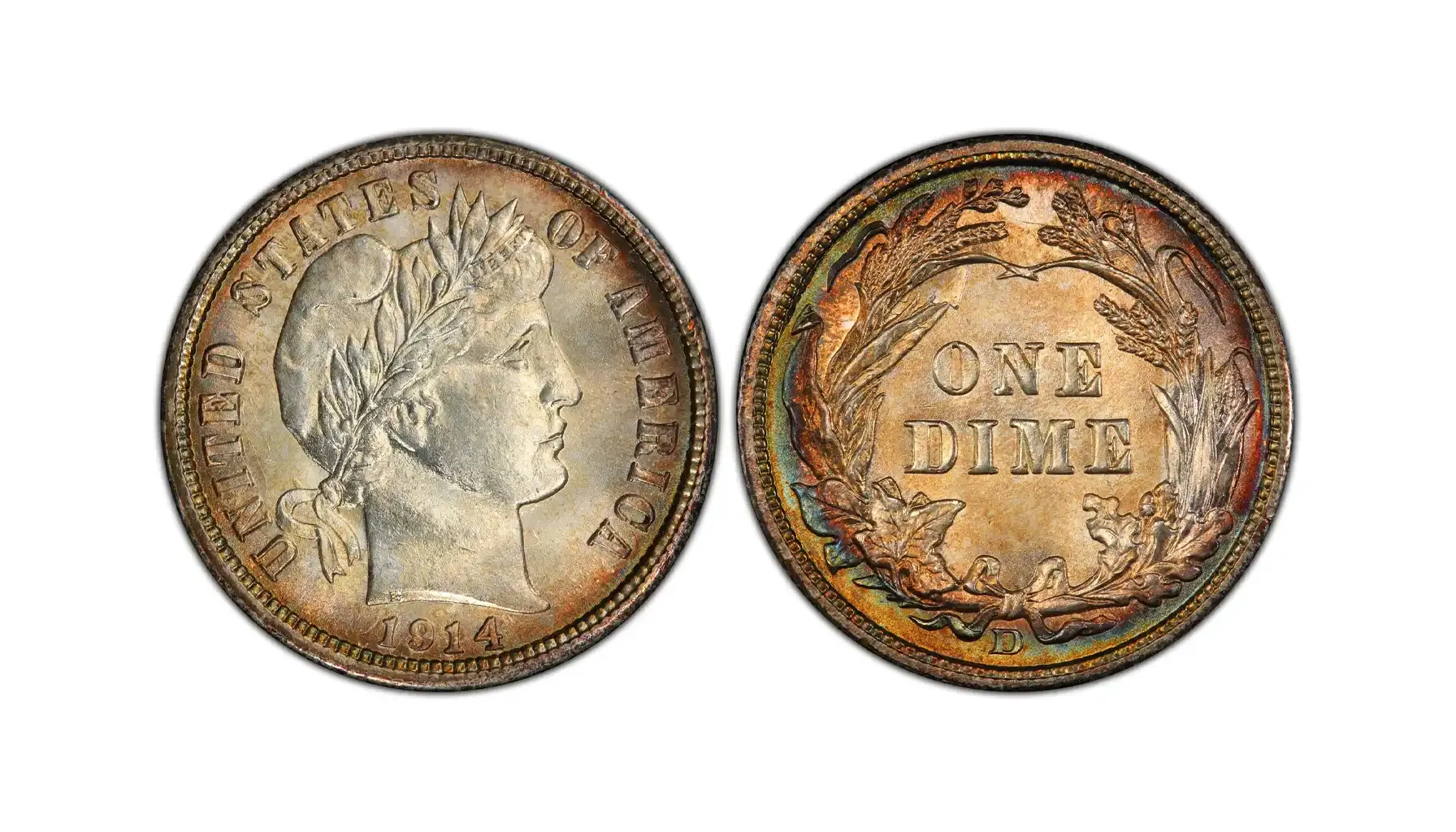
How to identify mint marks by location and size
Inspect the obverse above the date: Look for a tiny “D” or “S” just above the “4” in “1914.”
Compare mark size: Denver’s “D” is slightly larger and more rounded than San Francisco’s “S.”
Use consistent lighting: Shine a bright light at an angle to cast shadows and reveal mint marks.
Check multiple examples: Compare your coin to known Philadelphia (blank), Denver (“D”), and San Francisco (“S”) specimens.
1914 D Barber Dime: Scarcity and Value
Denver’s 1914 D dime remains a rare find for collectors. The 1914 D dime value starts above average for Barber dimes of the era. Many dealers note that even worn examples sell for more than basic silver content. Collectors ask how much is a 1914 D dime worth when they find one in a roll. That question often returns answers showing modest to high premiums depending on condition.
Auction results show steep price jumps for top preserves. The 1914 D Barber dime value climbs sharply at MS60 and above. Examples graded MS63 routinely sell for several hundred dollars. When collectors wonder how much is a 1914 D Barber dime worth, they see that rare high grades can fetch over $1,000. Market momentum keeps pushing these prices higher year after year.
Long-term trends point to steady growth for this key issue. Dealers update listings monthly to reflect demand. If you ask what is a 1914 D dime value today, you’ll find that mid-grade coins hover around $200 to $300. That pricing shows how much collectors prize Denver’s low-mintage output.
Grade | Auction Price (Approx.) |
VF20 | $40 |
XF45 | $75 |
AU55 | $120 |
MS60 | $250 |
MS63 | $500 |
MS65 | $1,200 |
3 signs of a high-grade Denver coin
Sharp rim detail with full denticles visible
Clear Liberty band lines without flattening
Smooth fields free of major contact marks
1914 S Barber Dime: Why This Mint Mark Stands Out
The San Francisco Mint struck fewer Barber dimes in 1914 than Philadelphia or Denver. As a result, the 1914 S Barber dime value often tops the charts for that year. At lower grades, these coins trade for $10–$15, while mid-grade examples reach $75–$100. Collectors watch these prices closely.
High-grade survivors remain extremely scarce. When someone asks how much is a 1914 S Barber dime worth, they often see that MS60 coins start at $250. Examples graded MS63 or higher can pass $500 at auction. That price action shows why many collectors chase the 1914 S dime value today.
If you want to know the 1914 S Barber dime value today, check the latest auction results. Premiums spike in MS65 and above, where a single example may reach $1,000 or more. That helps you gauge the value of a 1914 S Barber dime today before buying or selling.
You can also ask: Is the 1776 to 1976 Quarter Dollar a Good Investment? Comparing both coins helps you make informed decisions across different series.
3 reasons the S mint mark is harder to find
San Francisco produced fewer coins, reducing overall survivors
Higher-grade examples rarely entered circulation, limiting availability
Many were melted for bullion, decreasing the population of well-preserved pieces

1914 Dime Errors and Varieties: What to Watch For
Off-Center Strikes
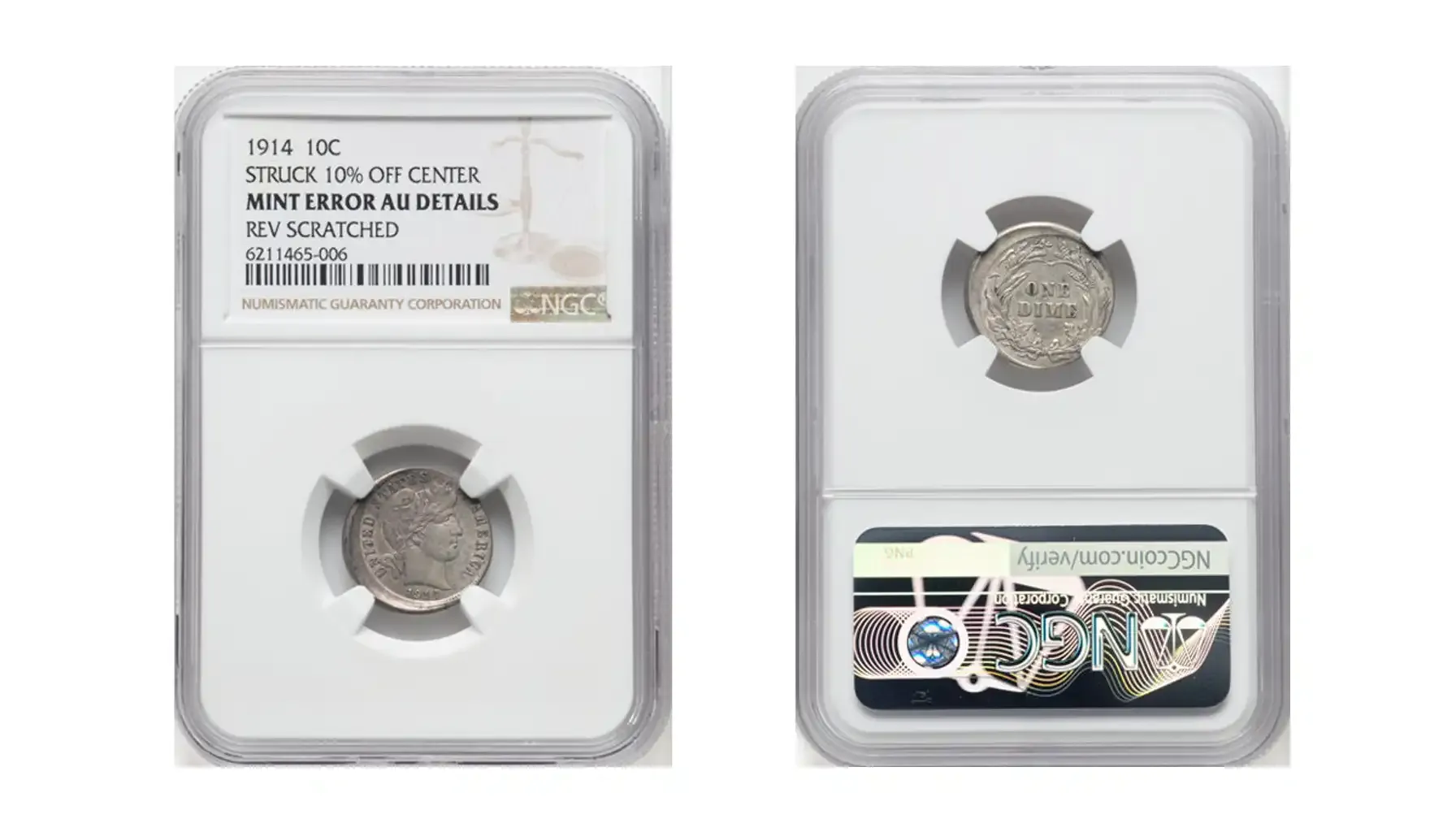
An off-center strike occurs when the planchet feeds unevenly. The design appears shifted, often leaving blank fields. Collectors reference a 1914 dime error list with pictures to compare each misaligned example. Many collectors prize off-center dimes for their visual impact.
Check how far the design is shifted from the coin’s center
Look for a crescent-shaped blank area along the rim
Verify that the reeded edge appears partially or fully missing
Compare against a perfectly centered 1914 Barber
Die Cracks

Die cracks form when the working die develops fine fractures. You can see thin raised lines on the coin’s surface. Experts add these to the 1914 D dime error list when confirmed. Die cracks never repeat in the same pattern, making each example unique.
Inspect fields and devices for hairline ridges or raised veins
Use magnification to spot small cracks radiating from the rim
Compare against a known perfect die to see differences
Note that larger cracks often occur near high-relief areas, like Liberty’s headband
Repunched Mint Marks

A repunched mint mark happens when the mint mark punches twice in misaligned positions. You can see a faint secondary impression behind the main letter. Many collectors study 1914 dime error mint mark location guides to find these varieties. Each repunched mark tells a story about mint operations.
Look above the date for a double “D” or “S” mint mark outline
Verify that both impressions share the same font and size
Check for slight offset or rotation between the two images
Use oblique lighting to reveal the overlapping mint marks
Lamination Flaws

Lamination flaws occur when metal layers separate on a planchet. You can see peeling or flaking of the surface. Collectors value these as part of 1914 D dime error value and 1914 Barber dime worth with error discussions. Laminations stand out under bright light as irregular patches.
Inspect both sides for thin, lifted metal layers
Check edges for separated or flaking metal bits
Tap the surface gently to hear a dull, hollow sound
Use magnification to confirm repeated peeling patterns
Strike-Throughs

A strike-through appears when foreign material contacts the coin during minting. It leaves a raised blemish or “blob” in the field or device. Many collectors track 1914 dime worth with error and 1914 S dime error value to price these pieces. Each strike-through error shows a unique shape.
Look for unexpected raised spots in the fields or devices
Verify that the blemish does not match normal die features
Inspect under magnification to confirm embedded debris, like grease or metal
Compare multiple dimes to distinguish strike-throughs from die chips
For more error identification tips, see the Coin Error Identification Guide.
Composition and Silver Content of the 1914 Dime
The 1914 Barber dime carries 90% silver. Each coin contains about 0.0723 troy ounces of silver. You can calculate how much silver is in a 1914 dime by multiplying total weight by silver purity. That metal weight forms the basis for its melt value.
Collectors balance that melt basis with rarity. When people ask 1914 silver dime coin value, they include both silver content and collector demand. Even though melt value provides a minimum, rare dates and high grades push prices above metal value.
Today’s silver price places the melt value near $1.80 per coin. However, 1914 silver dime value today often exceeds this because of scarcity. If you wonder how much is a 1914 silver dime worth, check both spot silver and numismatic guides before buying or selling.
Coin | Silver Content (oz) | Melt Value (USD) |
1914 Barber Dime | 0.0723 | $1.81 |
Other 1914 Dime Types: Mercury and Mini Varieties
Misidentifications plague collectors when gauging the 1914 Mercury dime value. Many assume any silver ten-cent coin with a Mercury design carries full Barber‐dime history. This mistake skews answers to how much is a 1914 Mercury dime worth. Always study the obverse detail. Genuine Mercurys display sharp winged‐Liberty lines.
Even seasoned collectors can misjudge today’s prices for genuine pieces and replicas. The 1914 Mercury dime value today depends on condition and authenticity. Novelty pieces labeled a 1914 mini Mercury dime value sell cheaply but hold no numismatic merit. Confirm weight and diameter against known specifications. Coin flippers might use plated base metals to mimic silver.
Novelties circulate as souvenirs, prompting questions like how much is a 1914 mini Mercury dime worth versus a true Barber original. Many replicas hide under generic slabs without grading. Always buy through reputable dealers or third‐party grading services. Authentication paperwork saves thousands in avoidable mistakes.
Is a 1914 Liberty Dime Worth Collecting?
Collectors eyeing a Barber coin often ask about the 1914 Liberty dime value and ponder how much is a 1914 Liberty dime worth. They watch market trends and auction results to spot price jumps. Rare, high-grade specimens can attract savvy investors. Before buying, compare recent sales and check for any signs of wear. Establish a budget based on realistic expectations.
The absence of a mint mark can also affect worth. To gauge the 1914 Liberty dime no mint mark value, examine population reports and certified‐coin census data. Unmarked Philadelphia strikes often trade at a small premium over lower grades. Pay attention to eye appeal; coins with sharp devices and strong luster tend to outperform. Always ask for a third‐party grade report.
Naturally, tracking how much is a 1914 Liberty dime value today helps you decide if a purchase justifies insurance and secure storage. Store Barber dimes in inert holders or capsules to prevent scratches and toning. Insure high‐grade pieces through a specialist program that covers numismatic coins. For deeper guidance, see this Dime Value Chart.


